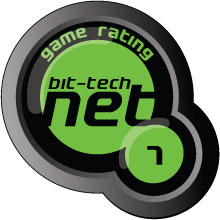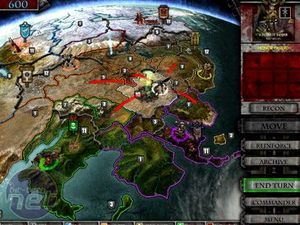Gameplay/Opinions
I believe that one of the main reasons the Dawn of War series is such a success is the resource gathering mechanics. An elaborate and improved system is used in Company of Heroes with great success. Gone are the days of hedgehoggin - sitting in your base whilst you continually gather resources to build the most ludicrously overpowering army that will crush down the enemy base in two seconds flat, without suffering a scratch, is now not easy.Dawn of War uses a rather unique system of capturing strategic points to provide requisition for your army. Requisition points are usually used in conjunction with power, sourced from power station-type buildings, to buy and build units and structures. The only exception to this rule is the Necrons, who capture points to increase building speed and solely use power, since they're robotic and that's just how they roll. The system works particularly well in making you focus more on the battles the game has to offer rather than building up a base, which essentially is the most entertaining thing about RTS games.
Similar to several other RTS games, Dark Crusade employs a commander or hero unit that is easily capable of handling several enemies at the same time. Although this is nothing new to the Dawn of War series, they do expand slightly to the campaign to add individuality to this expansion. When playing through the campaign, completing certain unset tasks (for example: getting a 3 – 1 kill ratio or defending a certain number of enemy attacks) your commander earns “Wargear”. It is up to you to select what Wargear to take first, and initially you won’t win or lose whole battles based on it. However, I found that it slowly made me more attached to my increasingly powerful warlord and as my arsenal increased my commander became almost godlike as he demolished his way through the enemy.
One criticism I do hold about the gameplay in Dark Crusade is the AI. Like many other titles, it suffers from the problems of mass computer-controlled units. Since Dark Crusade uses squad based combat, often when massing units into one large group and telling them to move to a certain location the consequence will be a huge line of units trying to walk together but still remain in their squad, resulting in them spreading out over a rather vast expanse when they reach their final destination. Additionally, the AI is unable to resolve unit collision issues, and if there is a vehicle trying to move one way and some infantry trying to march the other, whilst crossing a narrow passage, they will often either remain fixed there or go backwards and head out on an aggravatingly long route (Usually through the enemy's base to add to your annoyance).
Nevertheless, good micromanagement and understanding of the game can easily triumph over these little quirks. On the whole, the AI is easily capable enough to employ strategic and tactical manoeuvres such as ‘pincering’ and ‘flanking’ that provide the extra in depth logistics that a true RTS-er loves.
Overall, the gameplay is nothing specifically groundbreaking from the original game. The main addition here is the two new races. The Empire of Tau, a high-tech conglomerate of races fighting for ‘The Greater Good’, and the Necrons, an ancient and lethal breed of laser wielding, savage un-dead robots who pre-date even the Eldar. These two new races integrate very well with the previous five, adding two variable playing styles.
Graphics
Although the dated graphics engine hasn’t been overhauled you can evidently see that it has been tweaked. On full graphic settings, the game does require a reasonably powerful system but for the extra attention to detail, I found it 100% worth it. Everything seems to be a lot crisper, buildings and models have been sharpened when zooming in and the new glow effects on the weapons and units is a lot more convincing. A dedicated widescreen mode has been added and, if you have a suitable monitor, it really sets the game up with a cinematic feel. Sitting back and watching huge battles as war is waged is, quite simply, awe-inspiring.Each race has its own personal unique look and it is very simple to distinguish which units belong to which race in the battlefield. The two new races really show off the newly tweaked graphics engine and stay very true to their tabletop counterparts. The green glow from the Necron’s weapons really seems to emanate from each unit and the sci-fi look the Tau have when constructing buildings is magnificent.
Overall Relic has done a fantastic job in retaining the sci-fi gothic feel without making it too overbearing. The world of Kronus displays a wide range of environments from your ruffled snow at the peaks to your trampled grass and splattering mud in the dark and drab swamplands. Although the game can appear bleak at some points, the use of colour on the units easily surmounts this.
Conclusion
All in all, I wholly enjoyed leading my commander and his battalion on their own “Dark Crusade” through the campaign mode, getting pleasure from annihilating each race off the planet Kronus whilst witnessing my commander and his honour guard grow. The ambitious attempt at renovating the single player mode from the original linear structure, I believe, has been carried out by Relic with mostly flying colours. The two new added races integrate well with the original five, both unique in appearance and requiring vastly different playing styles.In contrast to Winter Assault, Dark Crusade adds enough extra content to earn itself the prestige of being a stand alone game (it does not require the original Dawn of War) - the only benefit of owning the other two games in the series is to unlock all the races in multiplayer mode. However, for not much more, I recommend buying the Warhammer 40,000 anthology to provide you with hours of entertainment this Christmas.
If you fancy tucking into some Warhammer action then you can pick it up for £14.99 from Play. Or if you fancy going the whole hog, for an extra £10 you can pick up the Warhammer Anthology coming in at £24.99.


MSI MPG Velox 100R Chassis Review
October 14 2021 | 15:04


















Want to comment? Please log in.